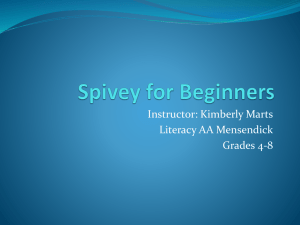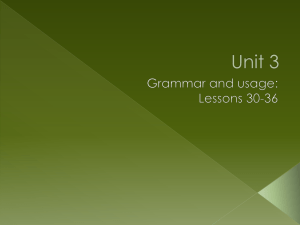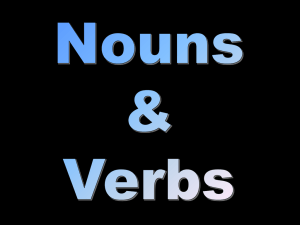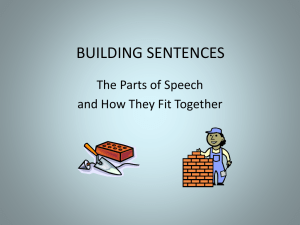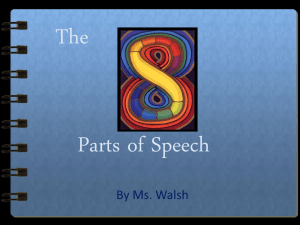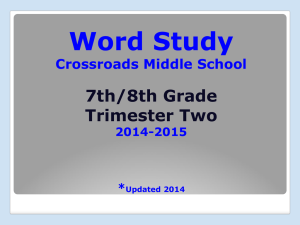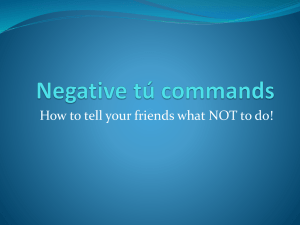Spivey and PIE Class
advertisement
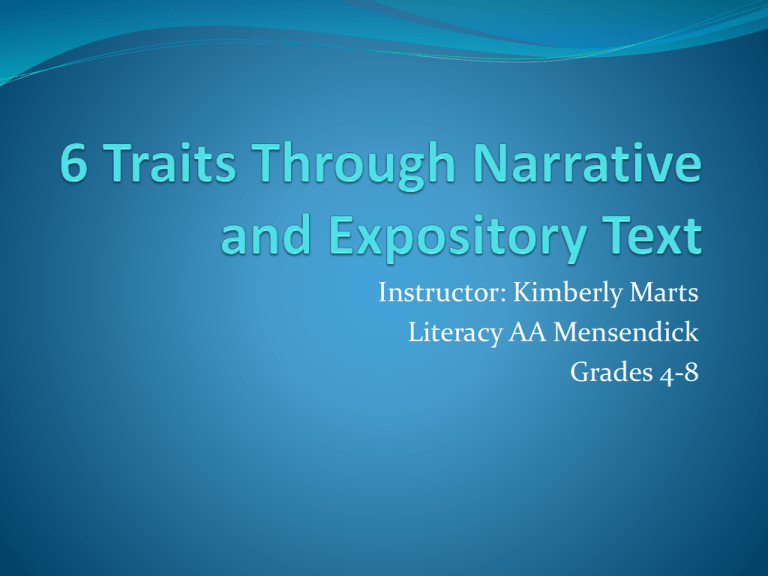
Instructor: Kimberly Marts Literacy AA Mensendick Grades 4-8 Main Sentence Trunk Simple sentence which includes a noun and verb. Equation: Noun + Verb. =MST Example: The dog jumped. The man slept. Creating Lists of Nouns and Verbs Nouns are words that are people, places, and things Ex. dog, cat, school, pencil On your graphic organizer, I am setting the timer-list as many nouns as you can in 3 minutes Verbs are Words that represent and action you can do. Ex. jump, sing, run, walk On your graphic organizer, I am setting the time-list as many verbs as you can in 3 minutes. Activity #1: Making Nouns and Verbs More Specific Taking general nouns and verbs and increasing the Word Choice by making them more unique or specific. Nouns: Dog-poodle, Doberman, Labrador Retriever Man- businessman, baseball player, couch potato Verbs: Jump- leap, lunge, bound slept-napped, snoozed, slumbered Activity: On your graphic organizer-you have 5 minutes to revise your nouns and verbs to stronger more powerful words by using the thesaurus (if needed) to build word choice and voice in your kids writing. Activity #1: Making Nouns and Verbs More Specific Nouns Verbs Dog-Doberman Jump-leap Man-couch potato Slept-snoozed Activity: Human Sentence-MST In pairs, the groups will use sentence strips to create human sentences that include the specific noun and strong verb. (Cooperative Learning) The group will go to the front of the room and act out their sentence while the class reads along, using hand signals. (Engagement) Clap hands over head= capital Punch in front= punctuation (period) **This can and should be used for all sentence types in class to increase motivation and engagement, by doing you promote better memory than just seeing** Checking Readability of Writing Go into Review Tab Select Spelling and Grammar Options (at bottom) Check Box-show Readability and press ok After you type in your sentence on a word document, select Spelling and Grammar, OK Your grade level score will come up. Ex. O=K and scores goes up from there by year As you add to your sentences or create chunks, you will add to the word document to show how the score increases by adding stronger nouns, verbs, adjectives, adverbs, various sentences, and expanders. Adding Adjectives and Adverbs (Descriptive Words to increase Word Choice and Voice) Adjectives are words that describe a noun to make it more visual and produce imagery The vicious Doberman The lazy couch potato Adverbs are words that enhance the verb and very often tell how the action happens. -aggressively jumped -sluggishly snoozed Activity: Add Adverbs and Adjectives to your Graphic Organizer Nouns (adjectives) Verbs (adverbs) Vicious dog (Doberman) Aggressively jumped (lunged) The lazy man (couch potato) Sluggishly slept (snoozed) Action Expander Sentences Add expander phrases that tell when, where, why, how, and condition to you descriptive MST Pass out sentence tree to glue in notebook Equation: MST (N + V) + 2-3 expanders. Example: During the show (when), the mysterious magician slyly (how) pulled a rabbit out of his hat on stage (where). Foldable Expander Activity Fold you paper in half the long way 3 times Open it up and write your name in the top box In order, going down the page, label specific noun, verb, how, when, where, why Create a model for the class up on the board with chart paper. Paired Model Activity- Model and Guided practice are done at the same time in sub steps Several Action Expander (Chunking) Taking the sentence you created, make it the first sentence of your paragraph. Continue the story to create a chunk no longer than 10 sentences using the topic from our sentence. Make sure it includes a variety of sentence lengths and beginnings (focus on sentence fluency) Several Action Expander During the Night, the sneaky shark quickly swam to catch his next victim. Swoosh! His fin flapped back and forth like a revolving door at Bloomindales. His eyes turned jet black. As the ocean grew darker, the shark’s smell of his prey grew stronger. CHOMP! His victim was caught in the dead of the night, now with one less leg. Fluency: Number of Words in each Sentence: #1 _______ #2 _______ #3 _______ #4 _______ #5 _______ #6 _______ #7 _______ Beginning words in each Sentence: #1 _______ #2 _______ #3 _______ #4 _______ #5 _______ #6 _______ #7 _______ Surround the Noun A sentence that uses description in order to make a noun more visual and to promote imagery. Equation: Adjective + noun + with/that adjective phrase+ verb phrase. (adv) The fluffy bunny with a white, bushy tail hopped along the meadow peacefully. Activity: Magazine Picture Round Robin Using different magazine pictures, puppets, or objects around the room, the students describe the object by surrounding the noun with and adjective and with/that descriptive phrase. Rotating around the stations or passing the object, students will create surround the noun sentences on their graphic organizers. (Increases Engagement) Surround the Noun Chunk Taking the sentence you created, make it the first sentence of your paragraph. Continue the story to create a chunk no longer than 10 sentences using the topic form our sentence. Make sure it includes a variety of sentence lengths and beginnings (focus on sentence fluency) Surround the Noun (Chunking) The magnificent magician with a sparkly magic wand slyly put the rabbit into his top hat. Tapping his wand on the brim, the crowd sat in awe. He tipped the hat over. Poof! The rabbit had disappeared into thin air. The crowd went wild. Suddenly, he tapped the brim two more times. Tap! Tap! In an instant, the rabbit popped its head out of the top of the hat, making the crowd go wild. His illuminating magic show turned out to a complete success. Fluency: Number of Words in each Sentence: #1 _______ #2 _______ #3 _______ #4 _______ #5 _______ #6 _______ #7 _______ #8 _______ #9 _______ #10 _______ Beginning words in each Sentence: #1 _______ #2 _______ #3 _______ #4 _______ #5 _______ #6 _______ #7 _______ #8 _______ #9_______ #10 _______ Renamer/Appositive Sentence The noun is renamed with a synonym (noun that relates or means the same thing) The renamer can be a role, job, name, definition, function, personality description Equation: Noun , renamer phrase, verb phrase. (adj/adv) Example: The fantastic professor, a knowledgeable resource, assisted the teachers in planning their lessons confidently. Activity: Renamer Organizer Model roles, jobs, functions, and personality descriptions of yourself on your page one at a time. After each type, have the students do their own for each type. Model your sentence for each type on the back. Have the students create a sentence for each type on the back of the page. Lower grade teachers, you can focus on a type at a time to avoid overwhelming you students and modify the worksheet. (provided examples for both graphic organizers for you) Renamer (Appositive) Sentence Chunk Taking the sentence you created, make it the first sentence of your paragraph. Continue the story to create a chunk no longer than 10 sentences using the topic form your sentence. Make sure it includes a variety of sentence lengths and beginnings (focus on sentence fluency) Renamer (Appositive) Chunk Abraham Lincoln, the 16th president, fought endlessly to pass a law to free the slaves. He believed that they should be emancipated from their owners. He tried preserved the union. Ulysses S. Grant was assisting in his efforts to take over the border slave states. Through many battles, Ulysses S. Grant succeeded and Lincoln finally achieved what he wanted all along. In the end, the 13th amendment was passed, freeing the slaves. He gave the Gettysburg Address. He was assassinated in 1865. Fluency: Number of Words in each Sentence: #1 _______ #2 _______ #3 _______ #4 _______ #5 _______ #6 _______ #7 _______ Beginning words in each Sentence: #1 _______ #2 _______ #3 _______ #4 _______ #5 _______ #6 _______ #7 _______ 3 Action Sentence Shows 3 sequenced verbs (actions) that the noun is doing All verbs are related All verbs are the same tense Variety of phrase length Equation: Noun + verb phrase, verb phrase, and verb phrase. (adv) Example: The majestic clown blew up balloons, shaped them into animals, and dazzled the crowd amazingly. Activity: Flip Book Take 4 pieces of paper and scaffold them to show about an inch of the paper below it and fold over the top to form 8 flaps. Place two staples at the top on the left and right side. Label the flaps from top to bottom : 3 Action Sentence noun (specific) verb #1 phrase #1, verb #2 phrase #2, and verb #3 phrase #3. On the back, write the completed sentence and draw a comic strip of the 3 actions the noun is doing. 3 Action Sentence Chunk Taking the sentence you created, make it the first sentence of your paragraph. Continue the story to create a chunk no longer than 10 sentences about the topic form your sentence. Make sure it includes a variety of sentence lengths and beginnings (focus on sentence fluency) 3 Action Sentence Chunk Corky Kyle created havoc wherever he went, messed up everything, and never cleaned up after himself. This annoyed everyone. Until one day, his mom decided to teach him a lesson. She took all the mess from the house and dumped it in his room. She even put the dirty dishes, laundry and garbage in his room. When he went to bed, he had nowhere to sleep. He had to clean up everything until he could get to his bed. He learned his lesson. He never made a mess again. Fluency: Number of Words in each Sentence: #1 _______ #2 _______ #3 _______ #4 _______ #5 _______ #6 _______ #7 _______ #8 _______ #9 _______ Beginning words in each Sentence: #1 _______ #2 _______ #3 _______ #4 _______ #5 _______ #6 _______ #7 _______ #8 _______ #9 _______ Expository Paragraphs Paragraphs that describe a topic with supporting details which include point (essential/relevant details) as well as additional information (elaborations). It includes a topic sentence and concluding sentence which has the main topic (MT) and narrow/paragraph topic (NT/PT). PIE Acronym-Anchor MT=Main Topic NT/PT=Narrow topic or Paragraph Topic P = Point *relevant information that relates directly to the narrow topic I/E=additional information *information that elaborates on the Point (relevant info) to add more information about the Point. Analyzing Text While paired-modeling on the document camera, model each step as you go to show your metacognition of your sub-objectives. Read the passage all the way through-focus on key word throughout Reread the passage and identify the MT and label it in blue (highlight key words) Reread the topic sentence and identify the NT/PT (highlight/label in blue). What about the MT am I learning about? Reread the passage, identify the points that directly relate to the NT and highlight in red Reread the passage, identify the additional information that adds or elaborates to each point and highlight in green. Sample Coded Paragraph-Anchor There are many different types (NT/PT) of bears (MT) in the world. Thee common types of bears are the polar bear, brown bear, and panda bear. Polar bears are found in the cold weather climates like Antarctica. Their fur is clear and takes on the color of their surroundings. Brown bears can be found in the mountainous regions of the Northeast. They are carnivores that feed on the meat of animals around them. Lastly, the Panda bears can be found in China. Their fur changes between the colors of gray, black and white, and brown. They feed on both bamboo and vegetation. Reformatting on PIE Chart Color Code PIE chart (MT/PT=Blue, P=Red, IE=Green) Label MT and PT/NT at the top and bottom of the PIE chart. Fill in 3 points that relate to the PT/NT Copying directly from the text, write the additional information in 2 or more word phrases that elaborate on each Point. Revise the phrases by paraphrasing the phrases, suing your own words. Add transitions words and expanders to increase fluency and variety of beginnings in your sentences. Reformatting Using PIE-Anchor MT Bears PT/NT Types P Polar I (frigid) cold weather E clear (see through) fur/takes on color of surrounding (environment) P Brown I lives (roams) in mountains of the Northeast E carnivore/feeds (devours) on meat P Panda I lives (resides) in China E feeds (munches) on bamboo/vegetation (herbivore) MT Bears NT/PT Types Summarizing Create a topic sentence which include the MT and NT/PT. Focusing on each section of the chart (PIE), write a variety of complex sentences rather than short, choppy simple sentences that include your Points (relevant) and Additional Information (IE). Create a concluding sentence which include the MT and NT/PT. Color code the paragraph to check that all information was included. (check for understanding) Summary/Body Paragraph Bears (MT) come in many different types (PT/NT). In Antarctica, a cold weather bear, also known as the polar, has clear fur which matches the color of its environment. Along the mountains of the northeast, the carnivorous brown bear devours the meat of its prey. Lastly, the veggie-eating panda bear lives in China and loves to munch on bamboo and other vegetation. All in all, a variety (PT/NT) of bears (MT) exist all around us.
